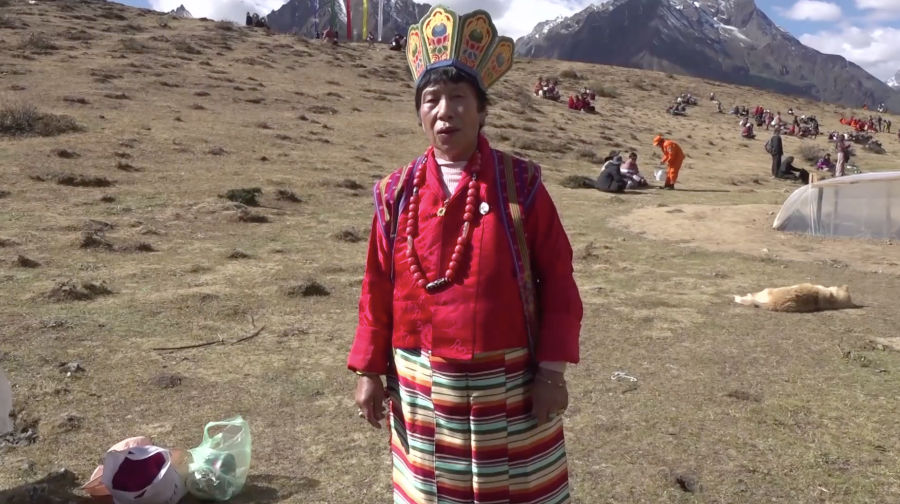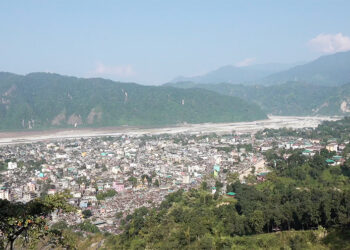 Chhundu Gongzhey is one of Haa’s oldest traditional songs, sung in praise of the valley’s supreme local deity Ap Chundu. Today, it is mostly performed by the elderly women of Katsho Gewog. Locals worry that this unique melody could be lost, as the younger generations show little interest in learning it. Although there is no written record of its origin, oral history suggests that Chhundu Gongzhey has been around for about 150 years.
Chhundu Gongzhey is one of Haa’s oldest traditional songs, sung in praise of the valley’s supreme local deity Ap Chundu. Today, it is mostly performed by the elderly women of Katsho Gewog. Locals worry that this unique melody could be lost, as the younger generations show little interest in learning it. Although there is no written record of its origin, oral history suggests that Chhundu Gongzhey has been around for about 150 years.
73-year-old Damchoe from Katsho Gewog in Haa leads the Chhundu Gongzhey troupe. Recently, she performed the traditional song at the Royal Highland Festival in Laya, alongside nine dancers from Katsho and Eusu Gewogs.

Chhundu Gongzhey performers are instantly recognisable by their unique costumes. They wear a cloth draped over the front of the Kira, a crisscrossed and folded Rachu, and a traditional headgear called Rig-nga. During the dance, they play a Draru, a religious drum. The verses they sing praise Ap Chhundu, the revered local deity of Haa Valley.
Aum Damchoe says the tradition of Chhundu Gongzhey is kept alive during special events, like the annual Haa Tshechu. But she worries it may fade as few young people today show interest in learning or performing it. She adds that losing this cultural practice could bring misfortune to the region since the songs are meant to honour and express gratitude to the local deity.
“I have been urging the younger generation to join us and learn the song, as it is part of our tradition and culture that we must preserve. However, they are not showing any interest. Instead, they argue with us, saying that we look like shamans and should do it ourselves. In fact, Chhundu Gongzhey is one of the original cultural traditions of the Haa region. I am certain this tradition will disappear after I am gone and if no one takes it up now. I am deeply worried and concerned about its survival.”
Originally, the dance was performed without a uniform, but later the district administration provided the performers with special costumes to preserve its traditional look.
Locals believe that the song serves as a bridge between Haa’s local beliefs and cultural expression.
The origin of Chhundu Gongzhey dates back to the time when Dasho Sonam Tobgay was sent to Tibet as Bhutan’s Ambassador. During his stay, he gathered the women of Jombu in Tibet and asked them to dance. While they danced, Dasho Sonam Tobgay noticed that Chhundu Gongzhey was being performed there as Jombai Paw. When he later returned to Bhutan after completing his tenure, Aum Rinchen Dem of Haa Watsa learned the song from him,” said Damchoe Dem.
Today, just over ten elderly performers, aged 55 to 73, continue to keep this traditional dance alive.
“We have been encouraging other women to join our group to learn and perform Chhundu Gongzhey. However, only a few have responded, and most ignore our requests. We are concerned that this cultural tradition may be lost. Traditionally, we are supposed to perform this song during the annual Haap Chhundu rituals. However, after attending the National Day celebrations in Haa, we have not performed the Gongzhey during the ritual period. Since then, no one has taken the responsibility, and we were not invited to participate either,” said Zangmo, Performer, Katsho Gewog, Haa.
Aum Damchoe and her troupe’s worries may soon ease. There’s hope for Chhundu Gongzey yet. The District Culture Officer said that plans are underway to include Chhundu Gongzey in all major events. Starting next year, the song will be taught to district dancers and included as a mandatory part of the annual Tshechu to help preserve this cultural treasure.
Changa Dorji, Wangdue Phodrang
Edited by Sonam Pem







